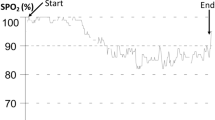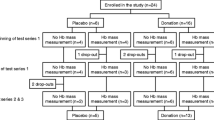Summary
Red cell indices were determined in 6 well trained runners before and after a 100 km race, and Coulter Counter (CC) determinations compared with calculated values derived from centrifuged hematocrit (ctrf), red cell count (CC) and hemoglobin measurements. The following changes were observed immediately after the race, as compared to values 3 days before: MCV(ctrf) decreased by 4.9% (p<0.001), MCV(CC) increased by 1.9% (p<0.05), MCHC(ctrf) increased by 4% and MCHC(CC) decreased by 3%. The increase in MCV(CC) suggests that intraerythrocyte osmolality was increased, this probably leading to swelling of the cells induced by a shift of water from the diluting Coulter Counter solution into the red cells prior to the MCV measurement. The decrease in MCV(ctrf) immediately after the race was not correlated with the increase in plasma osmolality. This suggests that plasma osmolality alone was not the key factor for regulation of red cell volume. The changes in MCV(ctrf), which contributed to a surprising stability of the hematocrit value and plasma volume, might represent a physiological principle for the maintenance of a favourable blood viscosity.
Similar content being viewed by others
References
Allen JE, Rasmussen H (1971) Human red blood cells: Prostaglandin E2, epinephrine, and isoproterenol alter deformability. Science 174:512–514
Buono MJ, Faucher PE (1985) Intraerythrocyte and plasma osmolality during graded exercise in humans. J Appl Physiol 58:1069–1072
Chien S (1974) Biophysical behavior of red cells in suspensions In: Surgenor DM (ed) The red blood cell, chapter 26. Academic Press, New York, p 1031
Chien S, Usami S, Dellenback RJ, Gregersen MI (1970) Sheardependent deformation of erythrocytes in rheology of human blood. Am J Physiol 219:136–142
Costill DL, Fink WJ (1974) Plasma volume changes following exercise and thermal dehydration. J Appl Physiol 37:521–525
Costill DL, Saltin B (1974) Changes in the ratio of venous to body hematrocrit following dehydration. J Appl Physiol 36:608–610
Costill DL, Branam L, Eddy D, Fink W (1974) Alterations in red cell volume following exercise and dehydration. J Appl Physiol 37:912–916
Demers LM, Harrison TS, Halbert DR, Santen RJ (1981) Effect of prolonged exercise on plasma prostaglandin levels. Prostagland Med 6:413–418
Dill DB, Costill DL (1974) Calculation of percentage changes in volumes of blood, plasma, and red cells in dehydration. J Appl Physiol 37:247–248
Fehr J, Knob M (1979) Comparison of red cell creatine level and reticulocyte count in appraising the severity of hemolytic processes. Blood 53:966–976
Gall G, Usher P, Melby JC, Klein R (1971) Effects of aldosterone and cortisol on human erythrocyte Na efflux. J Clin Endocrinol 32:555–561
Gilligan DR, Altschule MD, Katersky EM (1943) Physiological intravascular hemolysis of exercise. Hemoglobinemia and hemoglobinuria following cross country runs. J Clin Invest 22:859–869
Levere RD, Swerdlow F, Garavoy MR (1971) Measurement of human plasma hemoglobin by difference spectrophotometry. J Lab Clin Med 77:168–176
Maron MB, Horvath SM, Wilkerson JE (1975) Acute blood biochemical alterations in response to marathon running. Eur J Appl Physiol 34:173–181
Newmark SR, Himathongkam T, Martin RP, Cooper KH, Rose LI (1976) Adrenocortical response to marathon running. J Clin Encocrinol Metab 42:393–394
Rasmussen H, Lake W, Allen JE (1975) The effect of catecholamines and prostaglandins upon human and rat erythrocytes. Biochim Biophys Acta 411:63–73
Retzlaff JA, Tauxe WN, Kiely JM, Stroebel CHF (1969) Erythrocyte volume, plasma volume and lean body mass in adult men and women. Blood 23:649–661
Sachs L (1974) Angewandte Statistik. 4th ed. Springer, Berlin Heidelberg New York
StÄubli M, Roessler B, Köchli HP, Peheim E, Straub PW (1985) Creatine kinase and creatine kinase MB in endurance runners and in patients with myocardial infarction. Eur J Appl Physiol 54:40–45
Van Beaumont W (1973) Red cell volume with changes in plasma osmolarity during maximal exercise. J Appl Physiol 35:47–50
Van Beaumont W, Rochelle RH (1974) Erythrocyte volume stability with plasma osmolarity changes in exercising man. Proc Soc Exp Biol Med 145:240–243
Van Beaumont W, Underkofler S, van Beaumont S (1981) Erythrocyte volume, plasma volume, and acid-base changes in exercise and heat dehydration. J Appl Physiol 50:1255–1262
Wells CL, Stern JR, Hecht LH (1982) Hematological changes following a marathon race in male and female runners. Eur J Appl Physiol 48:41–49
Author information
Authors and Affiliations
Rights and permissions
About this article
Cite this article
StÄubli, M., Roessler, B. The mean red cell volume in long distance runners. Europ. J. Appl. Physiol. 55, 49–53 (1986). https://doi.org/10.1007/BF00422892
Accepted:
Issue Date:
DOI: https://doi.org/10.1007/BF00422892




